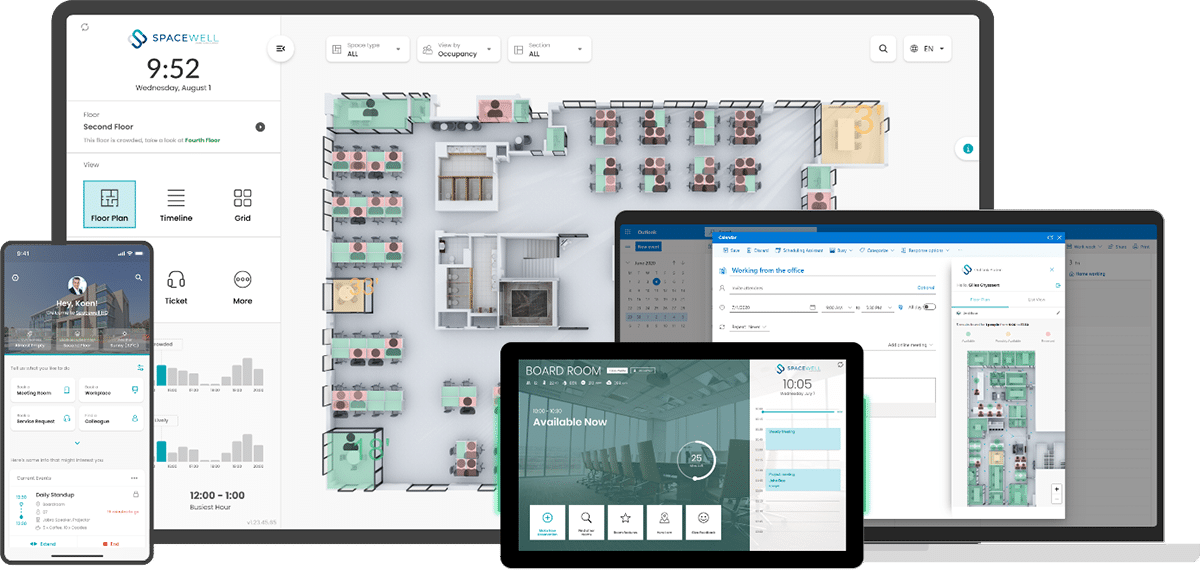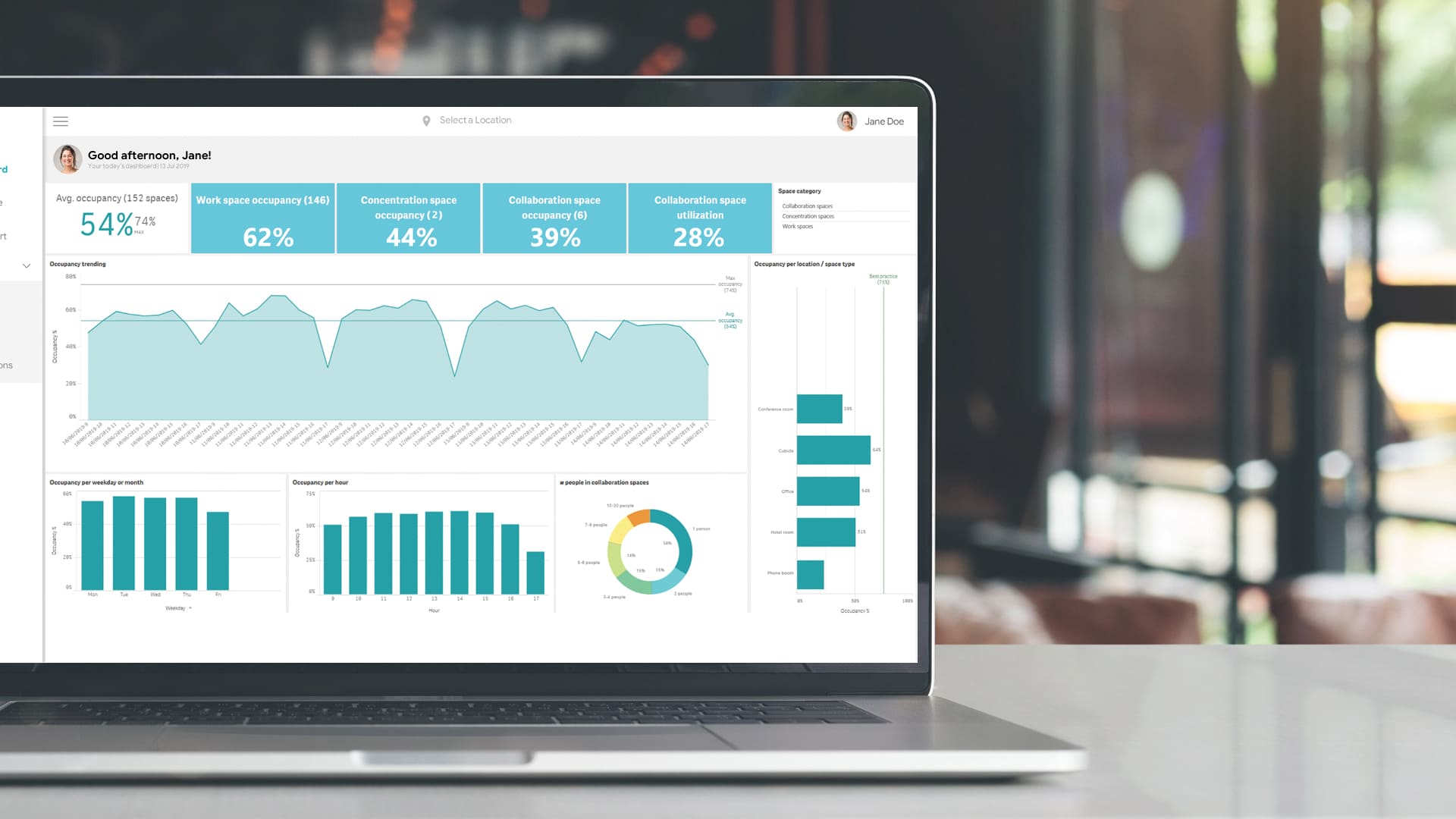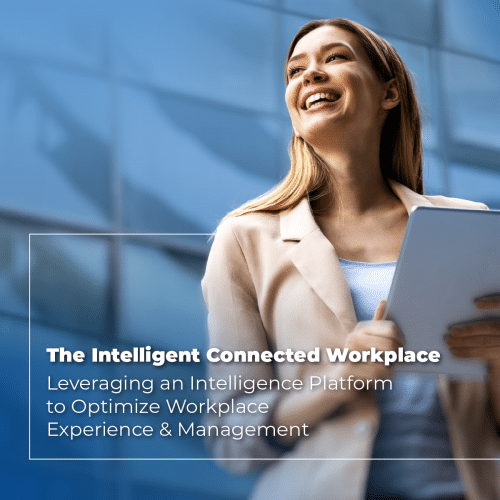Thanks to IoT sensor platforms for smart buildings, a building can now consistently offer flexible and comfortable workspaces, optimized for new ways of working.
Would you like to equip your organization with a solution to improve the well-being and engagement of your employees? Then you will find valuable tips here on how to enhance the work environment with smart building sensors.
Read also: Your Facility Is Ready for the Internet of Things – Are You?
Why turn your offices into smart workspaces?
The first question you’re probably asking yourself is: Why should I turn my offices into smart workspaces? Here are some answers.
Responding sustainably to deep trends in corporate real estate
Hybrid work styles are becoming mainstream Even though the trend isn’t new, it has accelerated sharply since the Covid 19 pandemic and is now taking hold for the long haul. Even companies that were initially reluctant to allow (partial) remote working have taken to it.
The degree of adoption varies from one sector to another, but in many organizations hybrid work is now an established norm. In finance or technology, for example, many employees work from home at least half of the time.
Therefore, it is in the interest of companies to sustainably adapt their premises to accommodate hybrid working. When employees come into the office now, they have new and different expectations. They see it as a place to meet, exchange and collaborate. Going to work is no longer a routine, but rather a voluntary choice. So it must be worth the commute.
Creating a workplace that improves productivity
What is the goal of any business leader or manager? That their teams are as productive as possible. When it comes to the work environment, that means creating a flexible space that allows for collaborative work, informal meetings, but also individual work that requires concentration. Not all employees are alike, and the same employee may have different needs on different days or even at different times of the day.
A company looking to improve employee productivity must therefore offer smart workspaces that provide a good experience. This means they must be able to flexibly meet different employee needs.
Flexibility is key
Flexibility is the key point of any hybrid workplace. With hybrid work, assigned desks don’t make much sense anymore, since employees are not present every day. By introducing flexible seating arrangements, managers can save space. The freed-up desk space can then be set up for collaborative work, as huddle rooms, quiet spaces for focused work, or bubbles for phone calls.
When done well, employees can take full advantage of workplace flexibility. It allows them to choose a space that suits their needs at any time.
The role of smart building sensors
So, how can a building become “intelligent” and enhance the occupant experience? A key component for this transformation is the wirelessly connected sensor, also known as IoT sensor.
IoT, sensors and smart buildings: how does this work?
IoT (Internet of Things) sensors are small devices that measure and detect changes in the environment. Placed across the workplace, they play an essential role in making spaces smart. These are three main benefits of leveraging sensor data in the workplace:
Optimal availability and accessibility of workspaces
Smart building sensors enable real-time information about workspaces to be transmitted to employees via their smartphones. This makes it easy for your workforce to find and reserve the spaces they need, with the right equipment and ambient conditions.
In addition, cleaning and maintenance crews receive instructions on which spaces have been used and what tasks need to be performed in them. This allows for more efficient services and optimal availability of resources.

Insights for long-term workplace planning
In addition to the real-time benefits, occupancy and utilization data from sensors provides essential information for long-term workplace planning. It is far more accurate than data obtained from traditional reservation software, because it measures actual space usage. Thus, it provides a reliable basis for setting up the right mix of spaces and determining the ideal space/employee ratio.
Improved health and well-being of employees
Certain invisible factors can be detrimental to employee well-being and productivity: insufficient ventilation, CO2 accumulation, etc. Studies show that poor air quality can even significantly alter cognitive functions or mood.
Thanks to connected sensors, it is possible to monitor air quality indicators and take effective measures to improve the well-being of employees.
Read also: How to Improve Indoor Air Quality Using Sensor Data
Smart building sensors can improve ecological performance
Smart meters, sensors, and other smart devices can also collect data on the ecological impact of buildings, particularly in relation to their energy consumption.
This data can then be processed and analyzed to derive actions to improve the building’s carbon footprint.
Choose the right software to make your buildings smart
Installing IoT sensors is not enough to make a building smart. To do so, you need a solution that can collect, process and analyze the data provided, and translate it into usable information.
Here are our tips for choosing the solution that will make your building intelligent.
Read also: How to select an IoT-enabled workplace software?
Start with the end in mind
First, you need to identify your use cases, which are the concrete goals you’re pursuing with the implementation of smart buildings sensors. This way, you avoid choosing a solution whose functionalities do not fully correspond to your objectives.
Consult independent reviews
To help you choose the right software, use benchmarking and recommendations from independent consulting firms, rather than relying solely on the claims of solution vendors.
Read also: Independent Research Firm Names Spacewell a Leader in IoT Platforms for Smart Buildings
Don’t get locked in
We recommend that you choose a hardware-agnostic solution that is capable of integrating data from different types of sensors. This will prevent you from being dependent on a single sensor vendor.

Demand advanced analytics capabilities
The primary function of smart building sensors is to provide actionable information. Therefore, it is highly recommended to choose a solution that has advanced analytics capabilities, and whose dashboards provide a dynamic view on what’s going on in your buildings. Static reports offering a snapshot are not enough.
Check out the integration possibilities
To get the full benefits of smart building sensors, make sure you choose a single platform that integrates IoT natively with workplace management software. A common mistake is choosing IoT and software solutions that integrate poorly and complicate real-time data exploitation.
A good solution is a mobile solution
Your building will only become truly intelligent if its users can access the data they need at any time and from anywhere. Therefore, the solution you choose must offer a mobile application that can be viewed on a smartphone or tablet and is intuitive.
Security and privacy
This may seem obvious, but it should not be taken lightly: your smart building sensors solution must meet all the security standards that your company and your business require. To do so, the IT department must be fully involved and its recommendations respected.
Read also: The ROI of Smart Workplace Investments (white paper)
In conclusion
Business leaders who are considering optimizing the workplace often face two pitfalls. Either they think that making workspaces smart is an almost unattainable dream. Or they imagine that simply implementing a software program to book desks and meeting rooms will be enough to adapt to new ways of working.
By being methodical and choosing the right solution for your needs, you can avoid both of these pitfalls and get a real ROI through better employee engagement and productivity.







